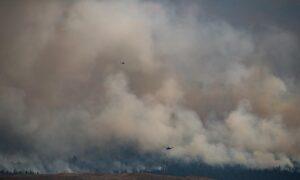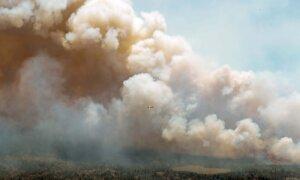Wildfire Season in Alberta and BC Starts Early with Hundreds of Blazes battled
Alberta has already had nearly double the number of wildfires it usually gets at this time of year–and the short-term outlook does not look much better.
“Conditions remain very dry,” Josee St. Onge, the province’s wildfire information officer, said at a news conference on April 24.
“We need significant and continued rain to overcome the drought conditions that we are experiencing across many parts of the province.”
Ms. St. Onge told reporters that 63 fires were burning in Alberta as of April 24. While most are relatively small, the province has already seen 205 fires in the spring of 2024, well above the five-year average of 120 fires.
One fire in the Municipal District of Peace in northwest Alberta has already burned 1,500 hectares.
Forestry Minister Todd Loewen said dry conditions in 2023 have carried over into 2024.
“We had an early spring and we had a low snow load,” Mr. Loewen said. “And those conditions alone are very conducive to wildfires. When you look at last year, we had a dry year last year too. So this all combines to conditions that lend itself to having more wildfires.”
In 2023, Alberta saw 2.2 million hectares burned by fires—a record amount. Tens of thousands of people had to be evacuated from their homes.
Mr. Loewen said the province has learned from the experience, and is better prepared to tackle fires this year–with measures ranging from hiring more firefighters to using new technology like helicopters with night vision.
He pointed to the 1500-hectare fire in the Peace Municipal District.
“We did work on that fire drive through the night, we have the night vision helicopter. And we also have fire crews that work through the night and [bulldozer] crews,” he said.
He is also asking people in Alberta to do all they can to help prevent fires.
“Everyone must do their part to safeguard their properties and communities by fostering wildfire resilience,” he said, listing measures like removing trees close to houses.
“These preventative measures play a crucial role in reducing human-caused wildfires when risk levels are high,” he said. “So far this season, we expect that almost all of the wildfires we’ve experienced so far this year are human caused.”
B.C. Wildfires
Next door in British Columbia, officials are also preparing for what they fear could be another bad year for wildfires due to drought conditions. So far this year B.C. has had 177 wildfires and has already had to bring in several evacuation alerts, including one in the Cariboo region because of the 1800-hectare Burgess Creek fire, which is still considered out of control.
The BC Wildfire Service says there are currently 115 active wildfires in the province.
On April 24, the province announced a five-month ban on “Category 3” open fires. The ban covers a large part of the Southern Interior in the Kamloops region, and it means no large open fires will be allowed, although the ban does not include campfires.
Like Alberta, B.C. suffered a record year for forest fires in 2023, with some 2.84 million hectares of forest burned, and tens of thousands of people evacuated.
Earlier this month the province’s Minister of Water Land and Resource Stewardship warned snowpack levels are the lowest in 50 years.
“The experts at the River Forecast Centre tell us these low levels and the impacts of year-over-year drought are creating significantly higher drought risk for this spring and summer,” said Nathan Cullen in a statement.
So far, the situation is not as severe in Saskatchewan and Manitoba.
Manitoba has had four fires so far this year, and none are currently burning according to an April 22 post by the province’s Wildfire Service.
In Saskatchewan, three fires were burning as of April 24, totaling 41 so far this spring. However, the province’s north has seen spring runoff well below normal, which means the risk could climb quickly. Some regions of the province have already brought in fire bans.
The time of year can also be bad for fires, according to Ms. St. Onge. It’s because forests have yet to “green up.”
“Snow has melted and exposed dead and dry vegetation which is extremely flammable,” she said.“Until vegetation green-up happens wildfires will easily Ignite and can spread very quickly.”





